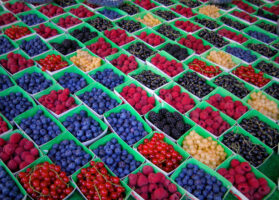Investment in South African citrus industry restrained by myriad recent challenges – USDA
Overview of citrus from South Africa in the U.S. market, complemented by charts from Agronometrics. Original published on December 23, 2022.
The widespread challenges that the South African citrus sector has faced over recent seasons are restraining investment in the industry, according to a USDA report.
The area under citrus cultivation in South Africa has grown steadily over the past decade, driven by ongoing investments on relatively high earnings from export markets.
Citrus from South Africa in the US Market | Volumes (KG)

Source: USDA Market News via Agronometrics.
(Agronometrics users can view this chart with live updates here)
As a result, South Africa is set for record citrus exports of 2.7 million tons in marketing year 2021-22, it said.
“However, the expansion in citrus orchards is expected to ease in marketing year 2022/23. Accelerating farming input costs, higher shipping rates, new phytosanitary regulations imposed by the European Union, inflationary pressures on consumers in key markets, and infrastructure inefficiencies are challenging South Africa’s citrus exports,” the report said.
“These factors are reducing the profitability of the sector, resulting in restrained investment in the industry.”
Headwinds in the orange industry
In the case of oranges, the report noted that South Africa exports to more than 100 countries around the world and the EU accounts for around 40% of total exports.
“However, despite a free trade agreement with the EU that allows duty-free access for citrus exports, South Africa continues to face phytosanitary challenges in the EU market due to the prevalence of citrus black spot (CBS) and false codling moth (FCM),” the report said.
The citrus industry estimates that it spends almost R4 billion (US$232 million) to comply with the CBS and FCM requirements in the EU market. The measures that have allowed South Africa to maintain and grow the EU market include pre-export inspections, strict spraying protocols, field surveillance programs, adherence to shipping protocols, and comprehensive CBS risk management systems.
As of July 14, 2022, the EU requires that imports of citrus fruit undergo specified cold treatment processes and precooling steps for specific periods before importation to ensure protection against FCM.
These changes were introduced in the middle of South Africa’s export season, which made implementation difficult and time sensitive. An estimated 1,350 containers of citrus fruit were detained at EU ports for several weeks, which resulted in an estimated R200 million (US$12 million) in losses on reduced quality and transaction costs.
South Africa launched a consultation process with the EU at the World Trade Organization in July 2022 regarding the cold treatment prescribed within the new regulations.
The News in Charts is a collection of stories from the industry complemented by charts from Agronometrics to help better tell their story.
Access the original article with this (Link)






